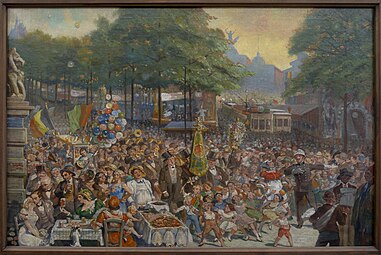Midi Fair
| Midi Fair | |
|---|---|
 | |
| Nickname | Kermesse of Brussels |
| Status | Active |
| Frequency | Annual |
| Location(s) | City of Brussels, Brussels-Capital Region |
| Country | Belgium |
| Inaugurated | 1880 |
| Attendance | 1.5 million |
| Website | Official website |
The Midi Fair (French: Foire du Midi; Dutch: Zuidfoor) or the Kermesse of Brussels (French: Kermesse de Bruxelles; Dutch: Kermis van Brussel) is the most important fair or kermesse in Brussels, Belgium, held since 1880. It takes place every year and lasts more than a month, starting on the Saturday preceding 21 July (Belgian National Day) and ending on the Sunday of the sixth fair weekend, in the second half of August.[1][2] The average of over 120 attractions draw more than 1.5 million visitors annually.[3][4]
History
The Midi Fair has been organised since 1880 on the Boulevard du Midi/Zuidlaan, part of the Small Ring (Brussels' inner ring road), between the Halle Gate and the Anderlecht Gate. That year, Brussels' city council decided to bring together the fairs of the Grand Place/Grote Markt, the Marché aux Grains/Graanmarkt and the Place des Martyrs/Martelaarsplein at this new location on the occasion of the 50th anniversary of Belgian independence.[5][6] Subsequently, a committee of traders and municipal councilors was set up in 1882 to organise the Brussels Fair. After some hesitation, the fair was renewed every year from 1885.[6]
Since its 19th-century origins, the Midi Fair—now the largest fair in Brussels,[3][6] extending over 1 km (0.62 mi) along the Small Ring—has evolved a lot and adapted to technological developments. Wrestlers' booths, fortune-tellers, steam-powered carousels and barrel organs have given way to purely technical attractions such as bumper cars, roller coasters, Ferris wheels, etc.[6] Snacks sold at food stalls include caricoles (periwinkles), crabs, French fries and smoutebollen (beignets).
The event was cancelled in 2020 due to the COVID-19 pandemic in Belgium. In 2021, the event's location was moved slightly up from its regular spot due to work being carried out on the future metro line 3 on the Avenue de Stalingrad/Stalingradlaan, leading to noise complaints by nearby residents.[7][4] That same year, the fair was included in the inventory of intangible cultural heritage of the Brussels-Capital Region under the listing: 'The living culture of the funfair'.[3] By 2022, however, the number of visitors had not yet returned to pre-pandemic figures.[4]
- The kermesse of Brussels of 1880, Léon Herbo, 1880
- Midi Fair in Brussels, Médard Tytgat, 1934
- View of the fair from the Boulevard du Midi/Zuidlaan, 1980
See also
References
- ^ "Midi Fair 2024". www.brussels.be. 10 April 2017. Retrieved 31 May 2024.
- ^ "Midi Fair". Musée des égouts. Retrieved 31 May 2024.
- ^ a b c "La culture vivante de la fête foraine — Patrimoine - Erfgoed". patrimoine.brussels. Retrieved 31 May 2024.
- ^ a b c Times, The Brussels. "Midi fair attracted fewer visitors than usual due to warm weather". www.brusselstimes.com. Retrieved 31 May 2024.
- ^ Roel Jacobs, "Midi, foire du" in: Serge Jaumain (red.), Dictionnaire d'histoire de Bruxelles (in French), 2013, p. 553
- ^ a b c d "Foire du Midi | Zuidfoor". Foire du Midi | Zuidfoor (in French). Retrieved 31 May 2024.
- ^ Amies, Nick (19 July 2021). "Residents make noise complaint after first weekend of Midi Fair". The Bulletin. Retrieved 31 May 2024.
External links
 Media related to Midi Fair at Wikimedia Commons
Media related to Midi Fair at Wikimedia Commons- Official website



